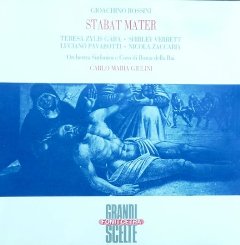Rossini - Stabat Mater (Giulini) [1967]
Rossini - Stabat Mater (1967)

1. Stabat Mater Teresa Zylis-Gara, soprano Shirley Verrett, mezzosoprano Luciano Pavarotti, tenor Nicola Zaccaria, bass Orchestra Sinfonica e Coro di Roma della Rai Carlo Maria Giulini - conductor Rec. Roma, 22 december 1967
Rossini's Stabat Mater was performed publicly in its final form in Paris on January 7, 1842. The first six sections of this ten-movement work had been composed earlier, on commission from Don Francesco de Varela, for an 1833 Good Friday performance in Madrid (with the last four movements written by Giuseppe Tadolini). The work was received enthusiastically in both of its incarnations and has remained a core piece of the choral repertory ever since.
Critics were initially less inclined to give their unqualified endorsement, however, citing its overtly operatic character. Nonetheless, one finds similar theatricality in other sacred music written by Italian composers (Verdi's Requiem is one of the most obvious) and whatever reservations one might cite are diminished by the sheer sweep and intensity of Rossini's music.
Scored for four soloists (two sopranos, tenor, and bass), chorus, and orchestra, the Stabat Mater features two movements for chorus and solo voices without accompaniment. Despite the near-decade separating the Eia Mater fons amoris (section five) and Quando corpus morietur (section nine), there is absolute consistency in style and inspiration.
The opening movement, Stabat Mater dolorosa, emerges out of the silence, first with orchestra, then orchestra joined by chorus, finally adding the soloists. Both solemnity and ardor are present. The second section, Cujus animam gementem, is a tenor aria of considerable difficulty, imposing on the singer a high D in its final moments. The springing naïveté of the vocal line and the metric simplicity of the accompaniment require that soloist and conductor approach the music with utmost dignity to avoid any sense of banality.
Section three is a duet for the two sopranos, Quis est homo, qui non fleret, often recalling duets the composer had written for his female protagonists in opera (Semiramide and Tancredi, for example). Pro peccatis suae gentis, an aria for bass, alternates between a bold, striding motive and a more reflective, flowing one. Wide-ranging, this section, too, demands a seriousness of approach by the soloist if a descent into simple bravura is to be avoided. Section five, Eia Mater, finds the bass soloist alternating with the unaccompanied chorus in a moment of sublime reflection. The quartet, Sancta Mater istud agas (section six), presents the four soloists, each of whom restate and recast the primary musical theme with remarkable invention.
Section seven, Fac, ut portem Christi mortem, is a cavatina for the second soprano, technically demanding with its broad intervals in the vocal line. Inflammatus et accensus (section eight) burns with the flaming intensity of its text. The writing here is bold and forward-looking, as unyielding as was Verdi's in the Libera me section of his Manzoni Requiem. The first soprano makes two incendiary ascents to high C over the full-throated chorus.
The unaccompanied Quando corpus morietur and the Amen comprise sections nine and ten, the latter a magnificent example of polyphony and imperative finality. ---Erik Eriksson, Rovi
download: uploaded yandex 4shared mediafire solidfiles mega zalivalka filecloudio nornar anonfiles oboom ziddu
Zmieniony (Niedziela, 27 Kwiecień 2014 20:39)








